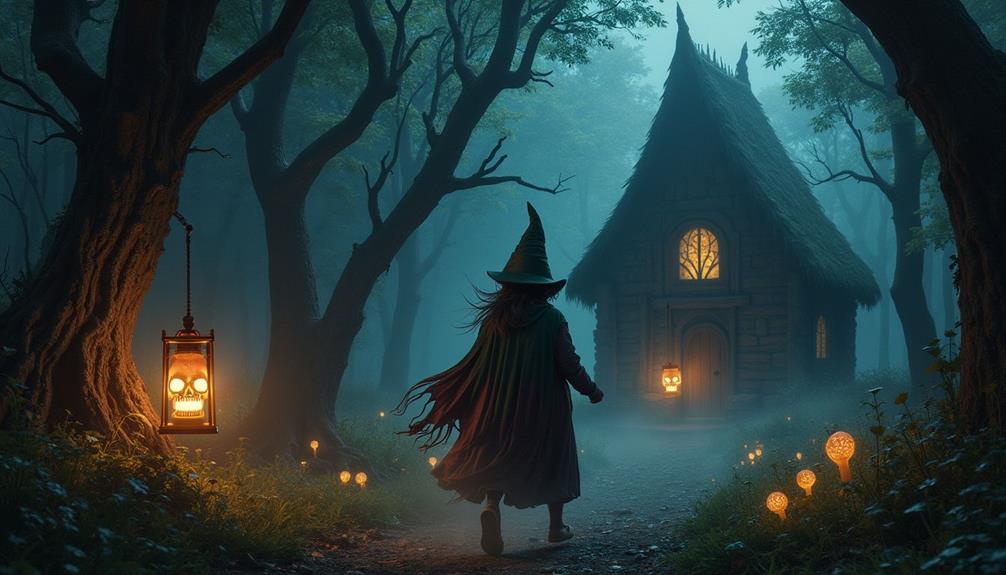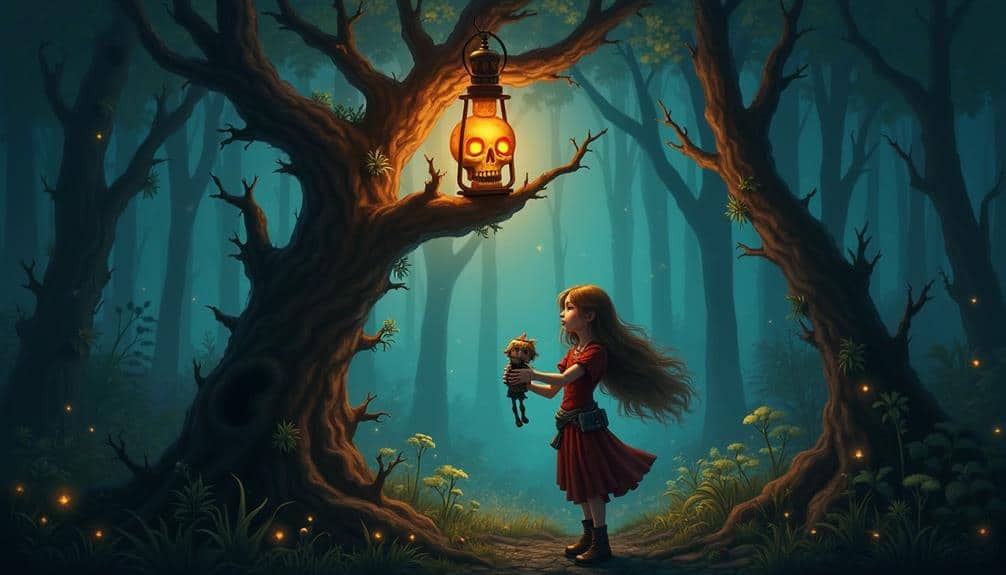When you explore the Russian tale of “Vasilisa the Beautiful,” you’ll encounter a story rich with themes of resilience and empowerment. Imagine a young girl, Vasilisa, who must navigate treacherous challenges set by her wicked stepmother, all while relying on a magical doll her mother gifted her before passing away. Her journey leads her deep into the forest where she meets the fearsome Baba Yaga, a witch who tests her in ways that transform her from a timid girl into a confident woman. What do these trials reveal about inner strength and the power of courage?
Origins of the Tale

The tale of Vasilisa the Beautiful has its roots deeply embedded in Slavic folklore, dating back many centuries. You’ll find that folklore influences have shaped this story, reflecting the cultural significance of the period. Oral traditions kept the tale alive, passed down through generations, ensuring that its character archetypes, like the virtuous heroine and the wicked stepmother, remain familiar.
Understanding the historical context is essential. This story emerged during times when oral storytelling was a primary form of entertainment and moral instruction. Each region in the Slavic world contributed its own variations, adding layers and depth to the narrative. You might notice differences in details, but the essence of the story stays the same.
The narrative structure is straightforward yet powerful, designed to impart moral values. Vasilisa’s journey emphasizes virtues like perseverance, kindness, and bravery. These themes resonated with people, reinforcing societal norms and expectations.
Regional variations might introduce different magical elements or challenges, but they all converge on the idea that goodness triumphs over evil. By exploring Vasilisa the Beautiful, you’re diving into a rich tapestry of cultural history and shared human experience.
Vasilisa’s Magical Doll

Among the many enchanting elements in Vasilisa the Beautiful, her magical doll stands out as an essential companion and symbol. When Vasilisa’s mother falls ill, she gifts her daughter this small, mysterious doll, instructing her to keep it close and feed it a little food whenever in need. This doll isn’t just a trinket; it’s a source of magical assistance and inner strength for Vasilisa.
Whenever you face challenges, the doll comes to life, offering wisdom and practical help. For instance, when Vasilisa is tasked with impossible chores, the doll’s guidance guarantees she completes them effortlessly. This magical assistance isn’t just about getting tasks done; it empowers Vasilisa to find her own inner strength, making her resilient against adversity.
You notice that the doll serves as more than a helper; it’s a manifestation of Vasilisa’s courage and determination. Even in the darkest moments, the doll’s presence reassures her, reminding her that she’s never truly alone.
It’s this unique bond that transforms Vasilisa from a vulnerable girl into a confident heroine. Through this magical doll, the tale beautifully illustrates the power of inner strength and the importance of unseen support.
The Wicked Stepmother

Despite the magical doll’s unwavering support, Vasilisa’s life remains far from easy, largely due to the presence of her wicked stepmother. This woman’s jealousy poisons the household, creating toxic relationships that affect everyone, especially Vasilisa. The stepmother’s jealousy stems from Vasilisa’s beauty and kindness, qualities she herself lacks and deeply envies. This feminine rivalry fuels her cruel behavior and psychological abuse, making Vasilisa’s daily existence a constant struggle.
In this toxic family dynamic, the stepmother’s negative parental influence is evident. She manipulates her own daughters to join in the oppression, isolating Vasilisa and forcing her to perform the most grueling chores.
Yet, Vasilisa shows remarkable resilience in adversity, never letting the cruelty diminish her spirit. Her ability to endure and overcome oppression speaks to her inner strength and character.
The psychological abuse inflicted by the stepmother is relentless, aiming to break Vasilisa’s will. However, Vasilisa’s inner fortitude and the magical doll’s guidance help her navigate these challenges.
This complex family dynamic underscores the destructive potential of jealousy and the power of resilience in overcoming hardship. The tension between Vasilisa and her stepmother sets the stage for her subsequent journey into the unknown.
Journey Into the Forest

One fateful evening, Vasilisa’s stepmother seizes the opportunity to rid herself of her stepdaughter by sending her on an impossible task—fetching light from the fearsome witch Baba Yaga, who dwells deep in the forest.
You can almost feel the weight of this cruel demand as Vasilisa steps into the dark, foreboding woods. The forest, with its thick canopy and eerie whispers, symbolizes the unknown and the trials Vasilisa must face to prove her worth and resilience.
As you follow her journey, you notice the path is fraught with challenges. The gnarled trees seem to reach out, their branches like skeletal hands trying to hold her back. Every rustle and distant howl tests her courage. The forest isn’t just a setting; it embodies the internal and external battles she must overcome. Vasilisa’s doll, a gift from her late mother, offers solace and guidance, reminding her she’s not alone.
With each step deeper into the forest, the journey challenges her resolve. The dense underbrush and deceptive shadows make progress agonizingly slow. Yet, Vasilisa’s determination remains unshaken, as she pushes forward, ready to confront whatever lies ahead.
Encounter With Baba Yaga

As Vasilisa finally emerges from the oppressive forest, her eyes widen at the sight of Baba Yaga’s eerie hut, perched on its chicken legs. The hut turns and creaks, almost as if it senses her presence. Taking a deep breath, she steps forward, determined to face whatever lies ahead.
Baba Yaga herself soon appears, her wild hair and piercing eyes sending chills down Vasilisa’s spine. The old witch’s motives remain unclear, but you sense a test is at hand. Baba Yaga doesn’t waste time; she scrutinizes Vasilisa, her gaze sharp and probing. You can almost feel the weight of her magical power in the air.
The witch’s motives become slightly clearer as she speaks. Baba Yaga seems intrigued by Vasilisa’s bravery and purity, qualities she rarely encounters in her dark dominion. She decides to set a series of tasks for Vasilisa, promising her aid if she succeeds.
As you watch, Vasilisa’s magical encounters begin. Baba Yaga summons enchanted creatures and objects, each more bewildering than the last. These encounters aren’t just tests of strength or skill but of Vasilisa’s character.
The atmosphere crackles with magic, and the true nature of Baba Yaga’s intentions starts to unfold.
The Three Tasks

Baba Yaga’s voice cuts through the tension, detailing the first of the three tasks Vasilisa must complete. You must sort an enormous sack of grains, separating the millet from the poppy seeds by dawn. This task seems impossible, but Vasilisa’s heroic perseverance and inner strength shine through.
With the help of her magical doll, a gift from her late mother, she accomplishes the task. This magical assistance represents the deep cultural significance of maternal blessings in Russian folklore.
The second task requires Vasilisa to clean Baba Yaga’s filthy hut and yard, a test of her diligence and resilience. Once again, Vasilisa’s self-discovery unfolds as she overcomes obstacles by focusing on her inner strength and the guidance of her enchanted doll.
This moment of personal growth highlights the feminine power rooted in endurance and meticulous care.
For the third task, Baba Yaga commands Vasilisa to gather and prepare enough firewood to last for several days. Vasilisa’s determination and the doll’s assistance make this arduous chore manageable.
Each completed task not only signifies her overcoming obstacles but also marks her journey towards self-discovery and personal growth in a world filled with challenges.
Escape From Baba Yaga

Despite the looming danger, Vasilisa’s courage doesn’t waver as she plans her escape from Baba Yaga’s clutches. She knows she must act swiftly and cleverly to outwit the cunning witch. Vasilisa’s bravery is her guiding star as she navigates the dark, eerie forest surrounding Baba Yaga’s hut.
You remember the magical doll Vasilisa carries, a gift from her late mother. This doll, imbued with wisdom, whispers advice and encouragement, helping her formulate a plan. Vasilisa listens intently, her heart pounding but her resolve firm.
As Baba Yaga’s wisdom has taught her to be ever-watchful, she sets magical wards and traps around her domain. However, Vasilisa’s quick thinking and bravery allow her to avoid these pitfalls. She seizes the moment when Baba Yaga is momentarily distracted, perhaps tending to her chores or conversing with her enchanted servants.
You can almost feel the tension in the air as Vasilisa quietly gathers her few belongings, including the glowing skull on a stick, a token of her success in completing Baba Yaga’s tasks.
With one last glance at the sinister hut, she slips into the shadowy woods, her heart racing but filled with hope.
Vasilisa’s New Beginning

Now free from Baba Yaga’s grasp, Vasilisa steps into a new chapter of her life, brimming with newfound confidence and determination. You can see Vasilisa’s transformation in every step she takes. No longer the timid girl overshadowed by her wicked stepmother and stepsisters, she now radiates with inner strength.
She returns to her village, her eyes no longer filled with fear but with the wisdom gained from her harrowing experiences. Vasilisa’s transformation is evident as she starts to rebuild her life, using the skills and knowledge she acquired during her time with Baba Yaga.
She’s no longer dependent on others; she’s learned to trust her instincts and abilities. Vasilisa begins crafting intricate dolls, each one a reflection of her journey and resilience. The villagers, once dismissive of her, now seek her advice and marvel at her creations.
You witness how she channels her inner strength into every aspect of her new life, from her relationships to her craft. This newfound confidence not only changes Vasilisa’s life but also inspires those around her. Her story becomes a demonstration to the power of transformation and the enduring human spirit.
Symbolism in the Story

As Vasilisa’s newfound confidence transforms her life, it’s impossible to ignore the rich symbolism woven throughout her story. The tale brims with feminine archetypes, representing various aspects of womanhood. Vasilisa herself embodies inner strength and resilience, emerging stronger from each trial she faces.
Her journey is steeped in transformation symbolism, illustrating the profound changes she undergoes from a vulnerable girl to a self-assured woman. The magical doll, a gift from her deceased mother, symbolizes maternal influences and the enduring power of love and guidance. This doll aids Vasilisa in traversing the challenges posed by Baba Yaga, the witch who epitomizes the struggle of good versus evil.
Baba Yaga’s character, one of the most iconic in Russian folklore elements, serves as a formidable adversary, testing Vasilisa’s courage and wit. The cultural significance of Vasilisa’s story lies in its empowerment themes, portraying a woman who overcomes adversity through perseverance and ingenuity.
As you explore deeper into the narrative, you’ll see how Vasilisa’s triumphs inspire readers to harness their own inner strength, embodying the timeless message of empowerment found in folklore.
Lessons From Vasilisa

Vasilisa’s tale teaches valuable lessons that resonate deeply with readers. One of the most prominent themes is courageous perseverance. Vasilisa faces numerous obstacles, from her cruel stepmother and stepsisters to the terrifying witch, Baba Yaga. Despite these intimidating challenges, she never gives up. Instead, she tackles each problem head-on, showing that perseverance can lead to triumph no matter how difficult the circumstances.
You also learn about inner strength from Vasilisa’s story. Her magic doll, a gift from her mother, symbolizes this strength. Even when she feels alone and scared, the doll’s guidance helps her navigate through her trials. This inner strength is what keeps her grounded and focused, proving that true power comes from within.
Moreover, Vasilisa’s journey emphasizes the importance of kindness and purity of heart. Her good nature earns her allies and ultimately helps her succeed. The story suggests that maintaining a kind and genuine heart, even in the face of adversity, can lead you to achieve your goals.
In essence, Vasilisa’s tale isn’t just about overcoming external hardships but also about tapping into your inner resources, showing that courageous perseverance and inner strength are keys to conquering life’s challenges.





